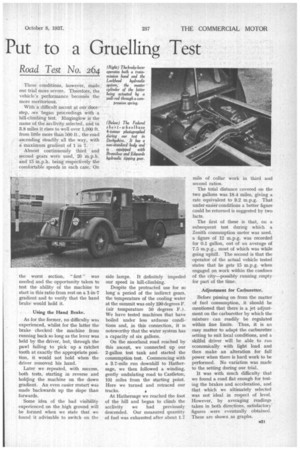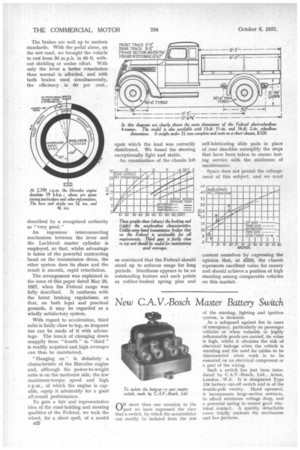The New Federal Put to a Gruelling Test
Page 54

Page 55

Page 56

If you've noticed an error in this article please click here to report it so we can fix it.
Road Test No. 264
Sturdily Built 4-tonner Proves Itself Highly Suitable for Hard Service Under Exacting Conditions: Hill-climbing and Braking
Characteristics Specially Noteworthy
FROM May, when Farmer Federal Motors, Ltd., was formed and the marketing of .Federal vehicles in this country was resumed, up to the end of the first week in September, 40 chassis were, we understand, sold. This considerable measure of success may be attributed largely, but not wholly, to the fine and not-forgotten reputation the make established in the British Isles during the first half of the 1040th decade.
It was, accordingly, with keen interest that we set out to test one of the latest chassis and to draw our own conclusions as to the ultimate fortunes of the Federal come-back.
After a day devoted to this purpose, and in spite of certain cikcumstances that may have reacted slightly against the formation of favourable impressions, we found ourselves convinced that its prospects are definitely good and that the indications already apparent of its achieving a fair share of popularity are based on genuine merit in respect of construction and performance.
To deal first with the worst, the unfavourable circumstances referred to resulted from atmospheric and
topographical conditionsand: from bad "weight distribution. Mist and. rain at times rendered speeds in
excess of 20 .in:p.h. hazardous:, •
The steep and-long hills by which Sheffield, the seat of the Federal British headquarters, is bounded, impeded the quick and straightforward execution of our tests. Moreover, the body, for which the Federal concessionnaire was not responsible, was mounted too far back on the chassis, so that an excessive proportion of the load was carried on the rear axle and the road-worthiness of the machine materially impaired.
These conditions, however, made our trial more severe. Therefore, the vehicle's performance becomes the more meritorious.
With a difficult ascent at our doorstep, we began proceedings with a hill-climbing test. Ringinglow is the name of the.acclivity selected, and in 3.8 miles it rises to well over 1,000 ft. from little more than 500 ft., the road ascending steadily all the way, with a maximum gradient of 1 in 7.
• Almost continuously third and second gears were used, 20 m.p.h. and 15 m.p.h. being respectively the comfortable speeds in each case. On the worst section, " first " was needed and the opportunity taken to test the ability of the machine to start in this ratio from rest on a 1-in-7 gradient and to verify that the hand brake would hold it.
Using the Hand Brake.
As for the former, no difficulty was experienced, whilst for the latter the brake checked the machine from running back so long as the lever was held by the driver, but, through the pawl failing to pick up a ratchet tooth at exactly the appropriate position, it would not hold when the driver removed his hand.
Later we repeated, with success, both tests, starting in reverse and haling the machine on the down gradient. An even easier restart was made backwards up the slope than forwards.
Some idea of the had visibility experienced on the high ground will be formed when we state that we found it advisable to switch on the side lamps. It definitely impeded our speed in hill-climbing.
Despite the protracted use for so long a period of the indirect gears, the temperature of the cooling water at the summit was only 190 degrees F. (air temperature 50 degrees F.) . We have tested machines that have boiled under less arduous conditions and, in this connection, it is noteworthy that the water system has a capacity of six gallons.
On the moorland road reached by this ascent, we connected up our 2-gallon test tank and started the consumption test. Commencing with a 3.7-mile run downhill to Hathersage, we then followed a winding, gently undulating road to Castleton, 1% miles from the starting point. Here we turned and retraced our tracks.
At Hathersage we reached the foot of the hill and began to climb the acclivity we had previously descended. Our measured quantity of fuel was exhausted after about 1.7 mile of collar work in third and second ratios.
The total distance covered on the two gallons was 18.4 miles, giving a rate equivalent to 9.2 m.p.g. That under easier conditions a better figure could be returned is suggested by two facts.
The first of these is that, on a subsequent test during which a Zenith consumption meter was used, a figure of 12 m.p.g. was recorded for 0.1 gallon, out of an average of 7.5 m.p.g., most of which was while going uphill. The second is that the operator of the actual vehicle tested states that he gets 15 m.p.g. when engaged on work within the confines of the city—possibly running empty for part of the time.
Adjustment for Carburetter.
Before passing on from the matter of fuel consumption, it should be mentioned that there is a jet adjustment on the carburetter by which the mixture can readily be regulated within fine limits. Thus, it is an easy matter to adapt the carburetter setting to suit local conditions, and a skilful driver will be able b run economically with fight load and then make an alteration for full power when there is hard work to be performed. No variation was made to the setting during our trial.
It was with much difficulty that we found a road flat enough for testing the brakes and acceleration, and that which we ultimately selected was not ideal in respect of level. However, by averaging readings, taken in both directions, satisfactory figures were eventually obtained. These are shown as graphs.
The brakes are well up to modern standards. With the pedal alone, on the wet road, we brought the vehicle to rest from 30 m.p.h. in 60 ft. without skidding or undue effort. With only the lever a better retardation than normal is afforded, and with both brakes used simultaneously, the efficiency is 60 per cent., described by a recognized authority as "very good."
An ingenious interconnecting mechanism between the lever and the Lockheed master cylinder is employed, so that, whilst advantage is taken of the powerful contracting band on the transmission drum, the other system does its share and the result is smooth, rapid retardation.
The arrangement was explained in the issue of this paper dated May 28, 1937, when the Federal range was fully described. It conforms with the latest braking regulations, so that, on both legal and practical grounds, it may be regarded as a wholly satisfactory system.
With regard to acceleration, third ratio is fairly close to top, so frequent use can be made of it with advantage. The knack of changing down snappily from "fourth" to "third" is readily acquired and high averages can thus be maintained.
"Hanging on" is definitely a characteristic of the Hercules engine and, although the power-to-weight ratio is on the moderate side, the low maximum-torque speed and high r.p.m., of which the engine is capable, equip it admirably for a good all-round performance.
To gain a fair and representative idea of the road-holding and stewing qualities of the Federal, we took the wheel, for a short spell, of a model B22 upoh which the load was correctly distributed. We found the steering exceptionally light and stable.
An examination of the chassis left us convinced that the Federal should stand up to arduous usage for long periods. Sturdiness appears to be an outstanding feature and such points as rubber-bushed spring pins and
self-lubricating slide pads in place of rear shackles exemplify the steps that have been taken to ensure lasting service with the minimum of maintenance.
Space does not permit the enlargement of this subject, and we must content ourselves by expressing the opinion that, at 1320, the chassis represents excellent value for money and should achieve a position of high standing among comparable vehicles on this market.




























































































